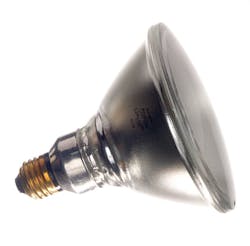How Halogen Can Reduce Operating Costs and Increase Safety at General Aviation Airports

In the United States, there are approximately 5,000 public use airports and roughly 3,000 of them are designated for general aviation (GA). Although these airports tend to have less traffic and smaller budgets than their larger commercial counterparts, they are still responsible for complying with FAA regulations as well as ensuring the safety of passengers and crews. Installing high-quality airfield lighting and approach lighting systems (ALS) is a crucial step for any airport regardless of classification and choosing the right lamps can allow budget-conscious airports to prioritize safety while also reducing operating costs.
Keeping airfields well-lit requires long-lasting lights that prevent disasters in the air, on runways and on taxiways. Incidents such as incursions – the incorrect presence of an aircraft, vehicle, or person on a runway – are far more likely to result in collision without proper lighting. Choices about airfield lighting come down to three different lamp types – incandescent, LED and halogen – each of which has distinctive pros and cons when it comes to cost and maintenance. At commercial airports, lighting systems are installed by third-party contractors employed by the FAA, meaning the airport itself has very little discretion when it comes to choosing the type of lamp. While GA airports aren’t subject to these restrictions, cost may put more expensive options like LEDs out of reach. For more budget-conscious GA airports, halogen provides a more durable alternative to incandescents while still being more affordable than LEDs.
The lighting needs of GA airports are distinct from those of their commercial counterparts. While larger airports have more extensive approach lighting systems that include ALSF systems, GA airfields typically rely on systems such as MALSR or other similar systems. A typical GA airport will have MALSR systems that include about 45 PAR38 lamps and 18 PAR56 lamps. As these systems help pilots align the aircraft with the centerline of the runway during instrument landing approaches, they also can be detected by the aircraft’s existing enhanced vision system. MALSRs can be invaluable when landing in conditions with zero visibility.
Runway, taxiway and other airfield lighting also benefit from the continued use of halogen lamps for reliability and durability. These lights employ PAR38 and two different PAR56 lamps depending on the weather and location – lamps that are easily available at low costs
Commercial airports that receive grants and sponsorship from the FAA may have the resources to convert directly to LED for their lighting needs. However, smaller airports without deep pockets may find the cost of installing LEDs to be prohibitive, as individual lamps can cost anywhere from $800 to $1,300 depending on the location. By contrast, halogen lamps offer significant savings with a cost of about $20 to $25. With the help of grant funding, GA airports may be able to adopt a hybrid approach of installing LEDs one section at a time while relying on halogen or incandescent lamps for the remaining sections. For smaller airports without access to grant funding, sticking entirely with halogen is a cost-effective option that does not compromise on safety.
In addition to cost, halogen offers another advantage over LEDs—high availability. Currently, there are no LED drop-in replacement bulbs for MALSR systems and the cost of installing the infrastructure for an integrated LED lighting system can top $2 million. For airports with limited resources, halogen provides a long-lasting alternative, offering up to up to 1000 hours of operation for the PAR38, and up to 500 for the PAR56.
However, the longevity of halogen can vary by location, since some airports don’t run their halogen lights for the minimum number of hours required to create a halogen cycle. In order to perform better than incandescents, halogen bulbs must reach sufficient temperature for the tungsten on the filament to evaporate and create a convection inside the lamp. While LEDs exhibit a longer life than halogen overall, they require an external heat source to melt ice build-up, whereas halogen bulbs generate enough heat to perform this function on their own.
Choosing the appropriate type of lamp for airfields can reduce airfield maintenance costs and ensure the maximum return on your investment. When allocating resources for your airfield, keep in mind that some approach lighting systems require more upkeep than others. For example, PAPI lights have very specific procedures for performing preventive maintenance whereas a PAR38 for a MALSR is much more straightforward. If a pilot notices a lamp on a MALSR system that needs to be replaced, they can usually call it in and get it taken care of without a lot of downtime.
If you’ve decided to use halogen exclusively or as part of a hybrid lighting solution, it’s important to pick a reliable product from an established manufacturer. Halogen lamps vary widely in terms of their longevity and durability, so it’s important to choose an established company with a proven track-record for quality and a sufficient range of products to cover your lighting needs.
Manufacturers should also be fully equipped with a light laboratory capable of performing photometric and spectral measurements, which ensure consistent light output throughout the beam. They should also verify that the lamp and reflector are compatible, ensuring superior photometric performance. Testing for durability is also a vital aspect of quality assurance, since lamps should be able to withstand high vibrations, particularly in the center line. Manufacturers can assess durability through a variety of tests, from dropping lead balls on bulbs to placing them on a vibration table.
Other features to look for include environmental and burst testing and whether the manufacturer offers an offline annealing process. This feature takes any extra stress out of the glass so that the lamp is better able to survive vibrations and cold weather.
For larger, commercial airports, the choice of a lighting solution is largely dictated by the FAA, but smaller GA airports have more discretion in selecting their lighting. However, it’s still important to know what options are available depending on your approach lighting systems and other airfield lighting. While LED lights offer superior longevity, they can be expensive, and features like drop-in replacements for airfield lights are still several years away. For airports on a budget, halogen lamps offer a durable solution at an attractive price point that will keep your airfield well-lit and safe for travel, even in the most challenging conditions.
John Fogel, Product Manager at Amglo, has worked with the company for more than 15 years in product development. He can be contacted at [email protected].
About the Author

John Fogel
Halogen Product Manager
John Fogel, Product Manager at Amglo, has worked with the company for more than 15 years in product development, qualifying products with the FAA and building partnerships. For more information, visit www.amglo.com.